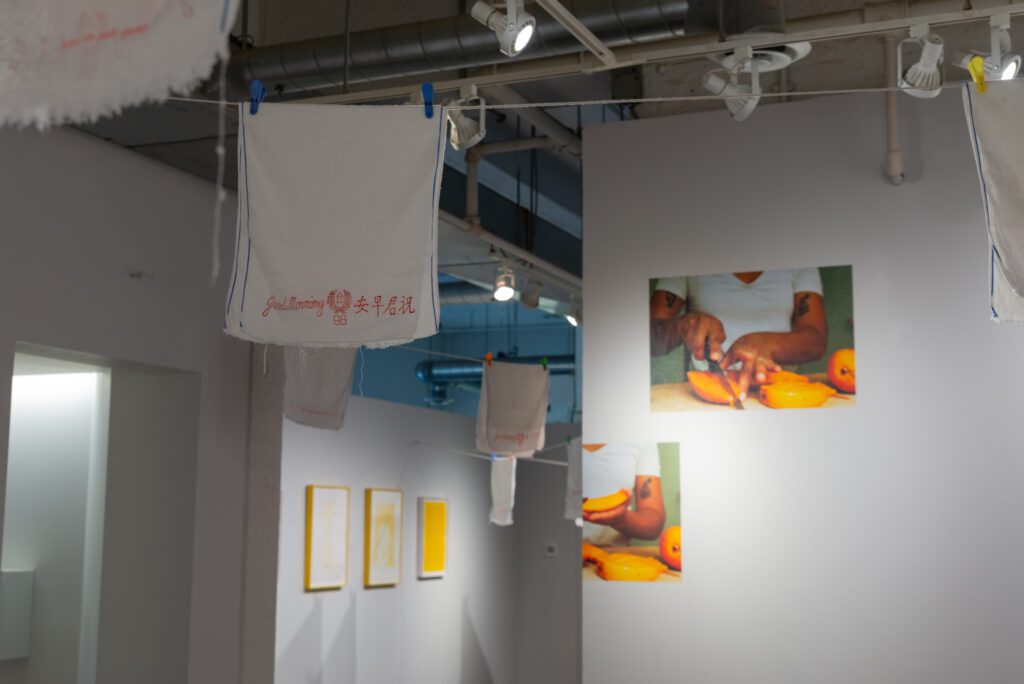Reaching for diasporic offerings
30 June 2025By Mahlet Cuff

Growing up in Winnipeg, there were grocery spots my parents took me where I felt right at home. These grocery stores are the ones that are locally owned, and filled with aisles of various spices, smells, and colours that replicate different variations of the Black/African/Caribbean diaspora. The store that I grew up with, and still frequent, is Dinos––right in the heart of downtown that began as a small store on Notre Dame Ave, and has since grown to move just a couple blocks over on Isabel. I remember as a child, this was the place that me, my mom, and siblings went to on the weekends to get special treats and stock up on foods that we could not get at the big box grocery stores. Not being able to understand the significance of such cultural food access as a child, this bi-weekly event was just another aspect of daily life for an immigrant family in a Canadian prairie city.
As such, I did not experience much diasporic longing or fully comprehended the importance of having access to food such Jamaican patties in a place where my family did not fully belong. As scholar R. Radhakrishnan notes in their essay, “The Changing Subject and the Politics of Theory:”
Diasporic subjectivity is thus necessarily double: acknowledging an earlier elsewhere in an active and critical relationship with the cultural politics of one’s present home … ‘Home’ then becomes a mode of interpretation in-betweenness, as a form of accountability to more than one location.1
However, for me the yearning came later in life, and now is ever so present in my embodiment as a balance between being Ethiopian hyphen Jamaican hyphen somewhat “Canadian.” I am still grappling with how to connect to a place (or places) that I have never visited, but have only experienced the cuisine that make up these locations. If I decide to remain in Canada, I do think there will be times where I feel that I am not fully grounded in the geographies that make up my family’s histories, but only through the combination of shared experiences in culturally relatable places. Tied together through the care of individuals who share the same complexity of knowing what their respective “home” is and what it could look like, I hope will provide an understanding of what it means for me to be situated on stolen land.

In the exhibition to be held in two hands, which took place at Martha Street Studio in Winnipeg during the summer of 2024, featured work by artists Sonali Menezes, based in Hamilton, Ontario, and Snack Witch Joni Cheung, an artist based between Montréal and Vancouver. They both use processes of screen printing, printmaking, photography, and video in their two-person exhibition. The show is a mediation on food and culturally-specific objects they both use to weave in and out of living in the hyphens of their respective Asian diasporic and Canadian identities. The works in this exhibition ask the viewer to sit with the question of what it means to be held in a way that feels true and authentic when living within hyphens of diaspora-ness. Both artists, dedicated not only to their own processes of understanding grief, love, and care, are also dedicated to one another’s commitments to shared knowledge of where they come from and how food informs the way they are in a relation to one another.
The Martha Street Studio main gallery space is filled with images of mangos on the walls and towels that hang from the ceiling on clothes lines. The towels by Cheung are reminiscent of childhood memories of seeing the good morning towel used by her family and folks working in Chinese restaurants. The towels are inscribed with messages laced in red that say “tucked into pants pocket” and “shooting back and forth like soft white darts.” These works become ephemera of sorts, the objects that hold memories and passed down histories––making them more than just mere towels, but a material that acts as a counter archive. This siting of counter archiving active in the towels offers an accessible way for the artist and viewers of the exhibition alike to connect with past and future generations.
This offering proposed a generous alternative way of holding stories, opening up the possibilities of how shared histories can be stored. Alongside the towels that hang delicately through the gallery space, some are also hung, perhaps more traditionally on the walls.
Nearby, Cheung has installed a ritualistic silent video work, where the artist’s face is disguised by their hands as they manually wash the towels “clean on a washboard.” Although the towels appear clean through usage of soap and water, food stains still remain. Pristine perfection does not exist within the diasporic experience––it is complicated and filled with questions, and so existing in the diaspora requires a constant journey of exploration to better understand oneself. The complications that are present in the diasporic experience allow for portals of constant transformation. Transformation that is not linear, but allows for a cycle of flux to take shape for the diasporic individual. Scholar Stuart Hall also describes the modern diasporic conundrum in their essay, “Cultural Identity and Diaspora:”
The diaspora experience is defined not by essence or purity, but by the recognition of a necessary heterogeneity and diversity; by a conception of ‘identity’ which lives with and through, constantly producing and reproducing themselves anew, through trans-formation and difference. not despite, difference; by hybridity. Diaspora identities are those which are constantly producing and reproducing themselves anew, through transformation and difference.2
To me, these kinds of transformations and difference take forms as the stains on Cheung’s towels, titled, bring back as souvenirs, 2019–ongoing, which hold memories of what food was cooked, what messes were cleaned up, and the conversations that are held in the seams of these towels, and further exemplified by the video work that depict the hands which wash them for their next use.
Adjacent to bring back as souvenirs is a video by Sonali Menezes. Installed across the gallery, the viewer is guided by Menezes’ voice as she talks to various family members about their relationship to mangos. In the case of How to Cut a Mango, the artist’s presence acts more as a guide for her interviewees, as she gently walks them through the process of properly slicing and dicing the mangos; in her tone, it’s apparent that the artist is engaging with their family members. The back and forth exchange between Menezes and her loved ones feels reciprocal as she is asking them to meditate on their own relationships to mangos from childhood to the present day, and Menezes’ tone is filled with curiosity and humour. When asked if her Aunty Beryl liked mangos, she passionately exclaims: “not liked, loved!”

The appreciation for mangos is ever so present to each of the interviewees, each time, Menezes is always offered a piece of the mango her loved ones cut up. I would interpret it being obvious, as this is a gesture offered to loved ones in my own cultural background, which also refers to the title of the show: to be held in two hands. With this work, Menezes has offered a gracious way of sharing her family’s relationship to cut mango while they are also holding her in two hands when they offer a piece of their beloved mango. The act of holding one another feels very necessary right now and will continue to be met with urgency. This piece reminds me we do need each other, in the simplest ways of giving one another food, which could relate in larger capacities towards dismantling the ways in which we collectively come together in times of grief. Another work by Menezes is titled All Hail Mangos pt 2, wherein the glimmery gold sheerness of the mango being held in Menezes’ hand feels filled with admiration and is reminiscent of the intergenerational sentiments that surround mangos within her own family.
to be held in two hands is successful in representing ways for the diasporic community to be in kinship with their cultural foods and material objects, asking questions and challenging the definitions of self-imposed hyphenated-ness and the lasting impacts of living in the in-between worlds. Works by both artists are in conversation with one another and encourage a sense of diasporic longing. For some of us whose families come from places that are constantly in states of crisis; where it sometimes feels impossible that I would have the means to go places that are supposed to be my home, like Jamaica or Ethiopia, because of the heavy burden of capitalism. The ideas of perfectionism that comes with accessing “home” and the anxieties of the lived realities of these places I have only dreamed of may not live up to my expectation. In the meantime while I sit in these uncomfortable feelings, I will turn to food as a grounding place to contemplate these questions with my loved ones and chosen family, and ask about their relationships to certain dishes, and what items they are able to hold onto while living in places that are only one version of home to them.
- R. Radhakrishnan, “The Changing Subject and the Politics of Theory,” in Diasporic Mediations: Between Home and Location (Minneapolis: University of Minnesota Press, 1996), 13-14.
- Stuart Hall, “Cultural Identity and Diaspora” in Selected Writings on Race and Difference, ed. Paul Gilroy and Ruth Wilson Gilmore (Durham: Duke University Press, 2021), 235.
Feature Image: Installation view of to be held in two hands, with work by Snack Witch Joni Cheung. Photo by Sarah Fuller courtesy of Martha Street Studio.



